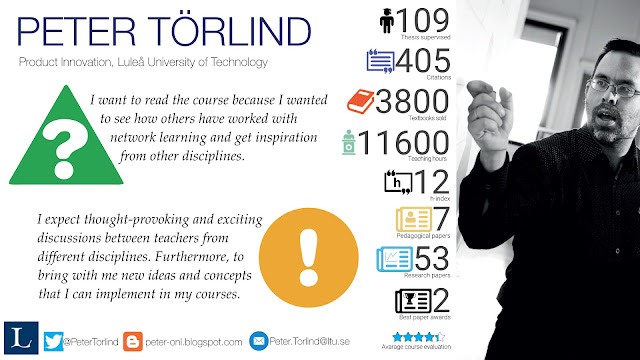Today we had a startup meeting at Luleå University of Technology. Before this meeting, I was expected to prepare one slide where I should present myself, why I wanted to join the course and my expectations. Creating all this in one slide is quite tricky, as the quote from President Wilson Woodrove (1918):
“That depends on the length of the speech,” answered the President. “If it is a ten-minute speech it takes me all of two weeks to prepare it; if it is a half-hour speech it takes me a week; if I can talk as long as I want to it requires no preparation at all. I am ready now.”
I really like to challenge my students to do similar things, but this time it was my challenge and I had a hard time to get everything down on one slide, but here it is!
 |
| My one-page slide presenting myself. |
When I reflect over it, it seems like I tried to add too much information in one slide, but I am still pleased with it.
The Luleå team
From Luleå we there are seven participants, one facilitator and one local organiser (person from Luleå pedagogical support) that will also be a co-facilitator in the course. The participants are from four different areas (civil engineering, health, computer science and engineering design). I really like to work in transdisciplinary teams, because I think that the different background really enriches the discussions. As my previous PhD student Mattias Bergström stated:
“the differences in opinion are a source of inspiration.” (Bergström 2009)
Karin and Sandeep presented the overall structure of the course, and the initial reflection is that I really like the structure with themes and reflection. I have some experience of attending online courses
 |
| Sandeep presents the structure of the course. |
We also performed the first ‘waving event’ trough zoom, it is always interesting to join a large group of new people where several persons are not used with technology.
 |
| First ‘waving event’ in the course |
Even though technology has improved a lot since my research was focused on distributed work, the following statement from 15 years ago is still true.
Complexity of tools; a general problem found in almost all studies are the different tools needed for global collaboration, all with separate advantages, user interfaces and limitations. The success of using collaborative tools depends greatly if the users are familiar with the technology and if the equipment (e.g. lightning, microphones and cameras) is adjusted properly; if not, problems can be difficult to locate and eliminate. Even broadband conferencing systems capable of high resolution conferencing with CD-quality audio can be ruined by using the wrong types of microphones or by acoustic feedback. (Törlind et al. 2005)
Still, with that many participants, I think that the first meeting went fairly well. Always feels a bit more unorganised that a local meeting. But still, there is much to do to improve the social presence – the feeling of being together that comes from the interactions among people (gestures, embodiment, spoken word, eye gazing, etc.) (Törlind 2015).
The PBL process used in the course
During the course, one of the concepts is the PBL concept of FISh (
Focus Investigate
Share). This is a model for PBL work both individually and in pairs and groups. The FISh model was developed by
Chrissi Nerantzi & Lars Uhlin (2012)
1 in the FDOL course (
Flexible,
Distance and
Online
Learning) course.
It will be interesting to see how this will work in distributed groups.
References
- Chrissi Nerantzi & Lars Uhlin (2012) https://fdol.wordpress.com/fdol131/design/ Retrieved Feb 25 2020
- Woodrove (1918) I have used the quote from President Woodrove many times before, but this time I did some research about the origin of the quote and found an interesting discussion here.
- Bergström, M. (2009). Probing for Innovation: how small design teams collaborate (Doctoral dissertation, Luleå University of Technology).
- Törlind, P., Larsson, A., Löfstrand, M., & Karlsson, L. (2005). Towards true collaboration in global design teams?. In 15th International Conference on Engineering Design (ICED 05).
- Törlind, P. (2015). Collaborative Design. Indian Institute of Science. Journal, 95(4), 353–363.
Footnotes
1 I tried to find a better reference but it seems like the main reference is the FDOL webpage.